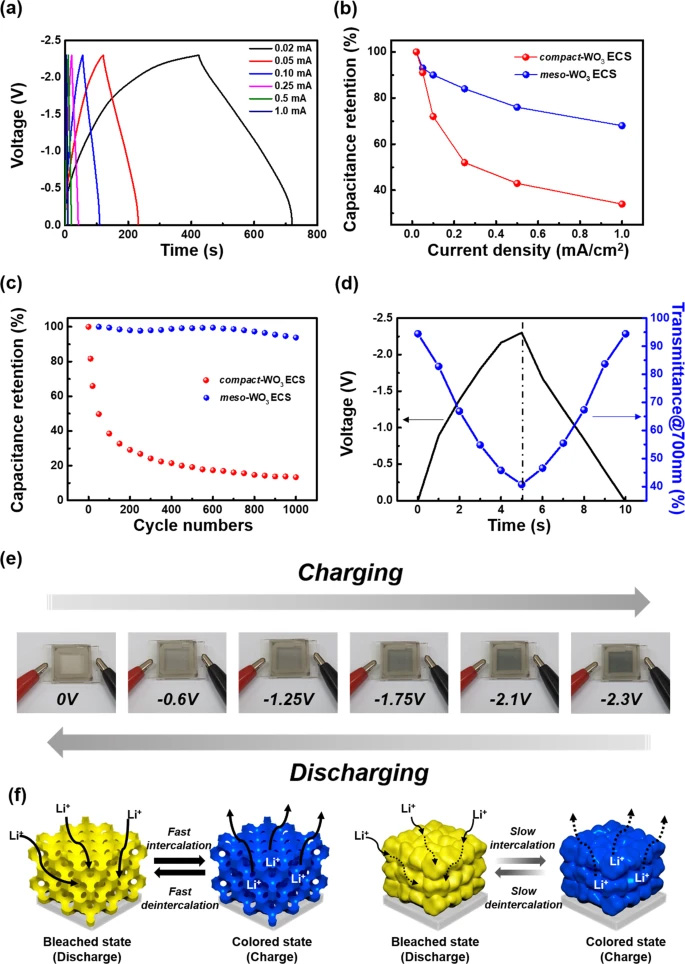During materials engineering, a network of tiny holes or pores can improve the energy storage capacity of materials for applications as smart windows. Electrochromic devices (ECDs), which control light transmittance through electrochemical redox reactions, have been widely used in electrochemical reflective displays or smart windows for energy efficient buildings. Recently, the functionality of ECDs has been extended to include energy storage, which is referred to as electrochromic supercapacitors (ECSs). ECSs have been increasingly studied as next-generation electrochemical components that can not only change their own optical properties but also store the energy supplied for coloration. In particular, their optical characteristics, such as color intensity, directly reflect the real-time levels of energy stored in these devices.
Smart windows are platforms whose light transmission properties can be altered when light, voltage or heat is applied. Scientists can control the fraction of light passing through the material using an electrical voltage to electrically switch from transparent to opaque materials during charge transfer. While this feature is associated with storage and release of energy, the same materials can be used for energy storage as well. In a new report, Jeon-Woo Kim and a team of scientists at the Pohang University of Science and Technology in South Korea developed and improved electrochromic supercapacitors made from tungsten trioxide (WO3). They used an evaporation-induced self-assembly process to deposit a film of tungsten trioxide with pores, where the porous architecture increased the speed of switching and capacitance in the material compared to conventional tungsten trioxide thin films. The work is now published on Nature Asia Materials.
During this work, Kim et al. demonstrated the ultrafast response of electrochromic supercapacitors by exploring the mesoporous structure of the constituent materials. Electrochromic devices (ECDs) can generate reversible color changes that correspond to electricity with promising applications across smart windows, displays and military camouflage. The devices can also control light transmittance to build materials for climate adaptive energy-efficient buildings. The functionality of ECDs can be extended to energy storage devices known as electrochromic supercapacitors (ECS). Such supercapacitors are increasingly under investigation as next-generation electrochemical components capable of changing their own optical properties and storing the energy supplied. Their inherent optical characteristics can therefore directly reveal the real-time energy levels stored within. Researchers had developed such high-performance devices using electrochromic chromophores based on transition metal oxides such as tungsten trioxide due to their superior electrochemical properties. The electrochromic displays developed here can change color based on their stored levels of energy and the product will have broad implications as next-generation smart window materials for buildings and portable energy storage.

Printing and evaporation-induced self-assembly
The team combined printing and evaporation-induced self-assembly to develop the highly functional, energy-storing, electrochromic supercapacitor displays. This printing process produced a micellar structure through the nozzle after evaporation, which they then subjected to sequential calcination and oxygen plasma treatment to form a patterned mesoporous WO3 device for energy-storing applications. When they charged the device, the patterns turned dark blue to indicate the charged state. To prove its mechanism of action, the team connected the device to a white-light emitting diode (LED) that initially emitted light, when the stored energy was consumed, the device returned to its original transparent state.
Outlook: next-generation smart electronics.
In this way, Jeon-Woo Kim and colleagues developed multifunctional electrochromic supercapacitors based on amorphous mesoporous WO3 films. Compared to the compact version of electrochromic supercapacitors (compact-WO3-ECS), the mesoporous electrochromic supercapacitors (meso-WO3-ECS) showed superior performance. The scientists credited this to its large surface area and amorphous nature. The mesoporous devices functioned rapidly to serve as electrochemical reflective displays and to store electrical charge. This setup can also power other electronic devices, as the color intensity of the pattern on the device indicated the level of stored energy within. The outcomes will have tremendous potential to form next-generation smart electronics.
More information: Keon-Woo Kim et al. Extremely fast electrochromic supercapacitors based on mesoporous WO3 prepared by an evaporation-induced self-assembly, NPG Asia Materials (2020). DOI: 10.1038/s41427-020-00257-w